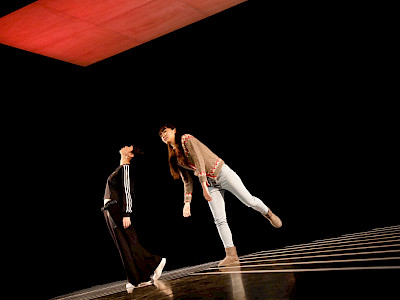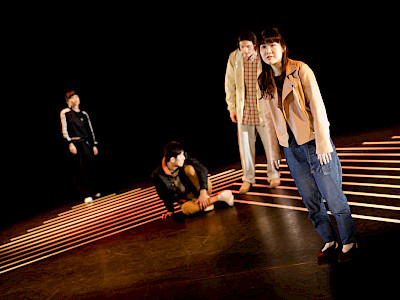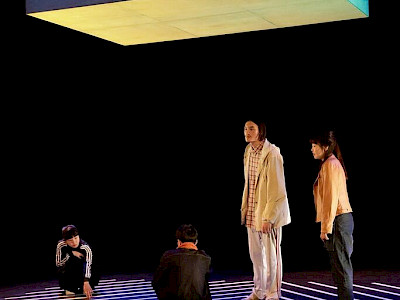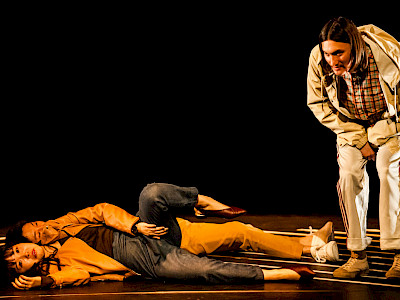23 — 26.05.2018
Toshiki Okada / chelfitsch Tokyo / Yokahama
Five Days in March – Re-creation
theatre
Japanese → NL, FR | ⧖ 1h30 | € 18 / € 15 (-25/65+) | Rencontrez les artistes après la représentation du 24/05
On the eve of the US-British offensive in Iraq on 21 March 2003, Japan joins the invading troops. This is Japan’s first military engagement since 1945, and it provokes many reactions. Against the background of a historical peace demonstration, the young adult characters in Five Days in March tell their personal stories of everyday life in Tokyo. This year, Japanese theatre-maker Toshiki Okada brings a new (!) adaptation of that iconic creation. The first presentation of Five Days in March (at Kunstenfestivaldesarts in 2007) was received with great enthusiasm and admiration. It marked Okada’s break - through in Europe and across the world. In his theatrical language, the logic between words and movement is unclear, as if these are two entirely independent forms of grammar. Balancing between the natural and the artificial, Okada uses stereotypical stories to sketch the profile of a generation of young people who have lost their way; their public participation in the demonstration contrasts with the (highest) personal concerns they share. Five Days in March is, once again, not to be missed.
Five Days in March depicted the everyday activities of a bunch of Japanese youngsters during five days in March, 2003, when the United States began bombing Iraq. It underscored the vague uneasiness felt by Japanese society about the contrast between a war in a faraway country and everyday life in Japan. With its script mirroring the actual colloquialisms of speech by young Japanese, its discourse changing style and space in the middle of speech, and its physical expression exaggerating subconscious gestures and other body movements, the work shook the framework of theatre to its very foundations and sent shockwaves through Japan's contemporary theatre world.
Five Days in March won the 49th Kishida Kunishi Drama Award in 2005 and had its first performance outside Japan at the Kunstenfestivaldesarts in 2007. It has since been staged in more than 30 cities around the world. As one of chelfitsch’s key works, it continues to be given the highest accolades inside and outside Japan, and is widely recognized as a landmark turning point in contemporary Japanese theater.
The ten-plus years following the debut of Five Days in March have seen a worldwide trend toward nationalism and a series of terrorist attacks that are gradually claiming “every day”. In the process, the perceived distance from war and street protests has been rapidly reduced. Today’s Japanese youth differs greatly from the picture of the apathetic youngsters depicted in the original work at the time of the attack on Iraq. Since the 2011 Great East Japan Earthquake, there has been an increase in protests and demonstrations led by a next generation, speaking out as social principals themselves.
For this re-creation of Five Days in March, auditions were held for young actors in their early 20s. Young Japanese people unavoidably feel the shadow of war approaching and sense that changes in society also affect their own lives. So, what will come into view when they act “apathy”? The re-creation will open up new perspectives on the work, thanks to young people in contemporary clothing.
Toshiki Okada: “Three years ago, I went to Beijing in the dead of winter. It was my first visit to China. I was stunned by the “youthfulness” of the city of Beijing. Never before, I had the same youthful impression of any other city. Tokyo, for example, never impressed me as being youthful. During my stay in Beijing, I felt the strong desire to an audience in this young city to see the play I had written nearly 15 years earlier and having Tokyo as its setting, just at the time when the war on Iraq began. This was the origin of a re-creation of Five Days in March. I subsequently decided to create a completely new version, differing greatly from the first one, and to re-make the play with young actors in their early 20s. I held auditions and chose seven actors. The youngest was born in 1997 and was still a pre-schooler when Iraq was attacked.
Although this is a re-creation, the text (script) alone is about the same as in the original version, although it, too, has been revised somewhat. Elements other than the text are all completely different. Above all, I myself have changed greatly. To put it simply, I have gotten older. And due to my experiences over the more than ten years since writing the first version, my thinking about theatre has changed substantially since then. Today, I define theatre as the action that a performance has on the viewer. Formerly, I thought theatre was merely the performance taking place on the stage. As I now see it, direction, therefore, means the task of making this action stronger and more precise. Nevertheless, the even greater and more decisive difference from before is naturally the difference in the times and circumstances surrounding us.
While this applies to the staging of any work in any place, if I may compare the staging of a piece to throwing a stone into a pond, the focus of my interest right now, as a theatrical artist presenting plays in various cities, is to see what kind of ripples will penetrate into our contemporary situation. It is always hard to predict in advance. That is why I always look forward to see it with my own eyes.”
Playwright & direction Toshiki Okada
Performers Chieko Asakura, Riki Ishikura, Yuri Itabashi, Ayaka Shibutani, Ayaka Nakama, Leon Kou Yonekawa, Manami Watanabe
Set design TORAFU ARCHITECTS
Technical director Koro Suzuki
Stage director Daijiro Kawakami
Lighting director Tomomi Ohira (ASG)
Sound director Norimasa Ushikawa
Costume Kyoko Fujitani (FAIFAI)
Assistant director Mana Inukai
English translation Aya Ogawa
Publicity photography Kenta Cobayashi
Executive producer Akane Nakamura
Chief producer Tamiko Ouki
Chief administrator Mihoka Kawamura
Production manager Mai Hyodo
Production assistant Megumi Mizuno
Administration assistant Takafumi Sakiyama, Minami Kambe
Production coordinator Yuka Sugiyama
Presentation Kunstenfestivaldesarts, Kaaitheater
Associated production precog co., LTD
Production chelfitsch, KAAT Kanagawa Arts Theatre
Co-production Kunstenfestivaldesarts, KAAT Kanagawa Arts Theatre, ROHM Theatre Kyoto
With the support of Toyohashi Arts Theatre PLAT, Nagano City Arts Center, Yamaguchi Center for Arts and Media [YCAM]
Residencies Toyohashi City, Toyohashi Arts Theatre PLAT
With the cooperation of Steep Slope Studio, Kinosaki International Arts Center
Subtitling with the support of ONDA


















